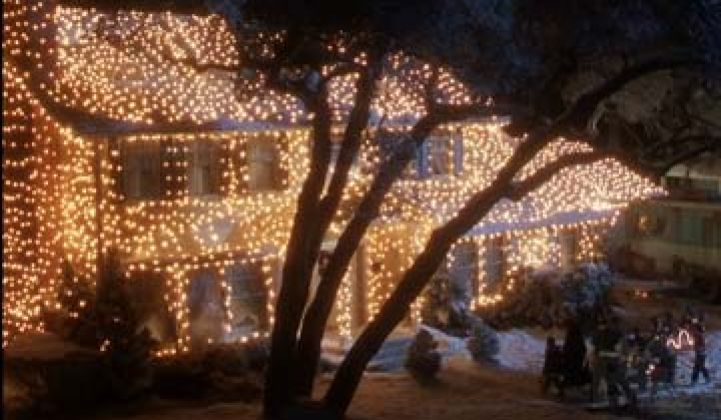Clark Griswold has a lot on his plate. After all, planning the perfect family Christmas is nearly impossible, as he finds out in what many argue is the best Christmas movie of all time: National Lampoon’s Christmas Vacation.
Hats off to the Griswolds for getting a real tree instead of using a fake one, as a real Christmas tree is a more sustainable option than a plastic tree. But why stop there? With his bonus check already spent before it arrives, should Clark Griswold consider switching to LED Christmas lights (assuming it’s not still 1985) to stop his electric meter from spinning out of control?
Pretending that Clark doesn’t already have a tangle of Christmas lights in his garage, let’s say he’s starting from scratch. In that case, he’ll need 250 strands of 100-bulb strings of lights. General Electric makes both LED and classic incandescent Christmas lights, so in the interest of making a direct comparison, we’ll use those.
Clark seems like the kind of guy who would shop on Amazon, where you can get General Electric micro LED lights in 100-bulb strands for about $16 each. Old-fashioned lights run about $10 a strand for the same amount of bulbs. Overall, that’s $4,000 in LED Christmas lights, compared to $2,500 for traditional technology. No wonder he doesn’t have enough money to cover the down payment for the pool.
The good news for Clark's son Rusty is that with LED lights, even if one of the bulbs is out, the rest of the strand will still work, said Jeff Cloud, lighting program manager of GE Lighting. The popularity of LEDs has been growing year over year, with GE seeing about 30 percent growth in sales each year and LEDs claiming about half of the market.
Although not having to toss an entire strand when one light goes out is tempting, the real appeal of LED lights is the clean, bright light for 80 percent less energy. A traditional strand of GE lights uses about 40.8 watts of energy, compared to 8 watts for the LEDs.
The average home runs their lights about six hours a day for six weeks, according to market research by GE. (Apparently, many people start decorating just after Veterans Day. By next year, it will likely start around Halloween.)
Obviously, Clark Griswold wasn’t so organized, so let’s assume the house is lit up for two weeks -- but for 12 hours a day. After all, this is a 'go big or go home' project.
If Clark has 250 strands of regular incandescent lights running for 168 hours during the holiday season, it will run him about $126 in utility bills, assuming he’s paying about 7.4 cents per kWh living in the suburbs of Chicago. If Clark paid the national average of 11.5 cents per kWh, he’d be out nearly $200. Maybe not enough to require a nuclear peaker plant be brought online, but I digress.
The switch to LEDs, however, would cost about $25 at 7.4 cents per kilowatt-hour. However, the original cost was still $1,500 more for the strands of LEDs. For the average Christmas reveler, who doesn’t wait until just before the crazy in-laws arrive to hang the Christmas lights and pays the national average for electricity, five strands of LEDs would cost about $1.18 for the season, compared to about $6 for incandescents. The payback would still take years, but hey, at least you wouldn’t have to toss an entire string when a single bulb blows out.
Clark’s real problem, however, is not the kilowatt-hours added to the bill, but the ampage. All of those incandescent lights would pull about 85 amps, more than most houses would have on a single circuit. By comparison, Cloud said just one breaker could easily accommodate the LEDs. But since he didn't even think to turn on the outlet he was using in the basement, maybe the amps running on a single circuit isn't Clark's biggest concern.
As the costs of LEDs continue to come down, the energy savings will keep looking better. But as for Clark Griswold, we don’t really want him to ditch classic Christmas lights. “We’d have nothing to laugh at,” Cloud said.



